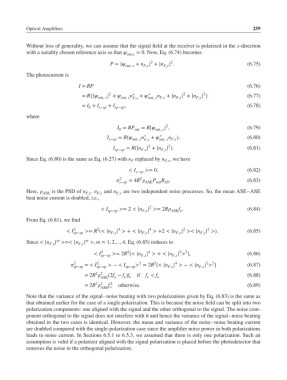Page 278 - Fiber Optic Communications Fund
P. 278
Optical Amplifiers 259
Without loss of generality, we can assume that the signal field at the receiver is polarized in the x-direction
with a suitably chosen reference axis so that out,y = 0. Now, Eq. (6.74) becomes
2
2
P = | out, x + n F,x | + |n F,y | . (6.75)
The photocurrent is
I = RP (6.76)
2 ∗ ∗ 2 2
= R{| | + n + n + |n | + |n | } (6.77)
out, x out, x F,x out, x F,x F,x F,y
= I + I + I , (6.78)
0 s−sp sp−sp
where
2
I = RP out = R| out, x | , (6.79)
0
∗
∗
I s−sp = R( out, x F,x + out, x F,x ), (6.80)
n
n
2
2
I = R(|n | + |n | ). (6.81)
sp−sp F,x F,y
Since Eq. (6.80) is the same as Eq. (6.27) with n replaced by n F,x ,wehave
F
< I s−sp >= 0, (6.82)
2
2
P B .
s−sp = 4R ASE out eff (6.83)
Here, ASE is the PSD of n F,x . n F,x and n F,y are two independent noise processes. So, the mean ASE–ASE
beat noise current is doubled, i.e.,
2
< I >= 2 < |n | >= 2R f . (6.84)
sp−sp F,x ASE o
From Eq. (6.81), we find
2
2
2
4
4
< I 2 sp−sp >= R (< |n F,x | > + < |n F,y | > +2 < |n F,x | >< |n F,y | >). (6.85)
m
m
Since < |n | >=< |n | >, m = 1, 2,..., 4, Eq. (6.85) reduces to
F,x F,y
2
2
2
4
< I 2 >= 2R [< |n | > + < |n | > ], (6.86)
sp−sp F,x F,x
2
2
2
2
4
2
2
sp−sp = < I sp−sp > − < I sp−sp > = 2R [< |n F,x | > − < |n F,x | > ] (6.87)
2 2
= 2R (2f − f )f if f < f (6.88)
ASE o e e e o
2 2 2
= 2R f otherwise. (6.89)
ASE o
Note that the variance of the signal–noise beating with two polarizations given by Eq. (6.83) is the same as
that obtained earlier for the case of a single polarization. This is because the noise field can be split into two
polarization components: one aligned with the signal and the other orthogonal to the signal. The noise com-
ponent orthogonal to the signal does not interfere with it and hence the variance of the signal–noise beating
obtained in the two cases is identical. However, the mean and variance of the noise–noise beating current
are doubled compared with the single-polarization case since the amplifier noise power in both polarizations
leads to noise current. In Sections 6.5.1 to 6.5.3, we assumed that there is only one polarization. Such an
assumption is valid if a polarizer aligned with the signal polarization is placed before the photodetector that
removes the noise in the orthogonal polarization.

